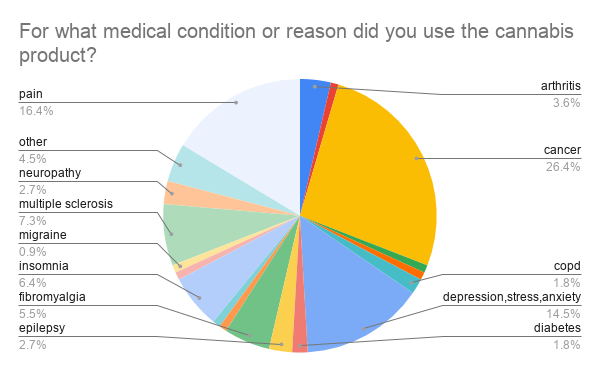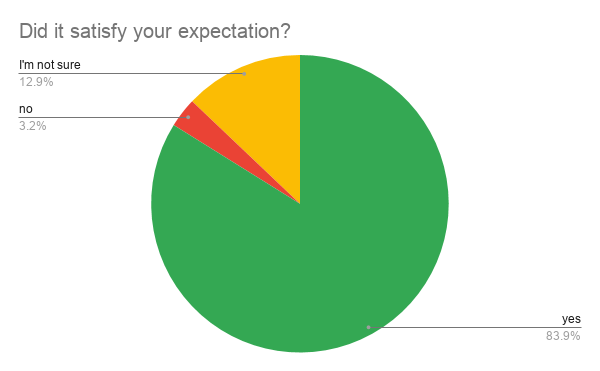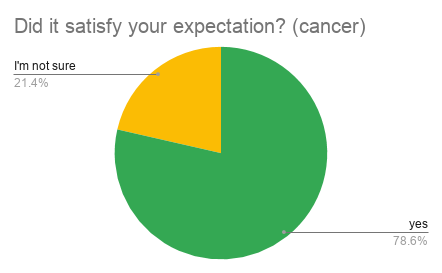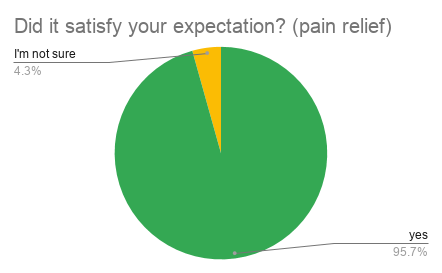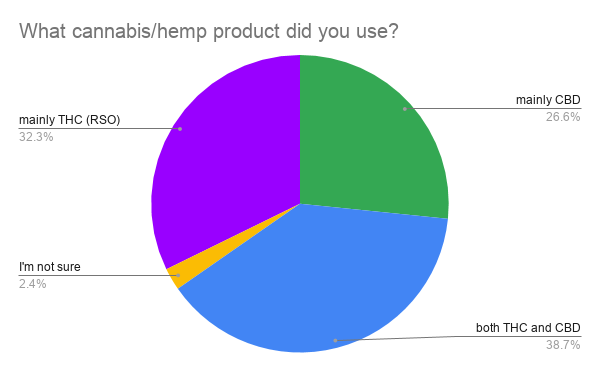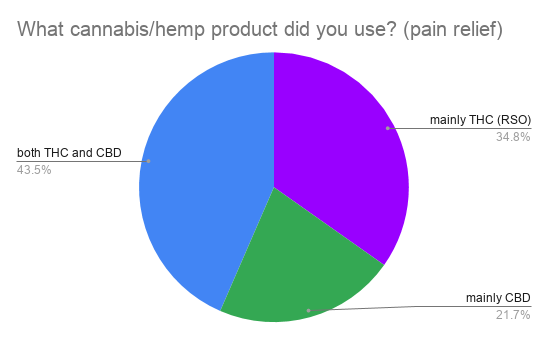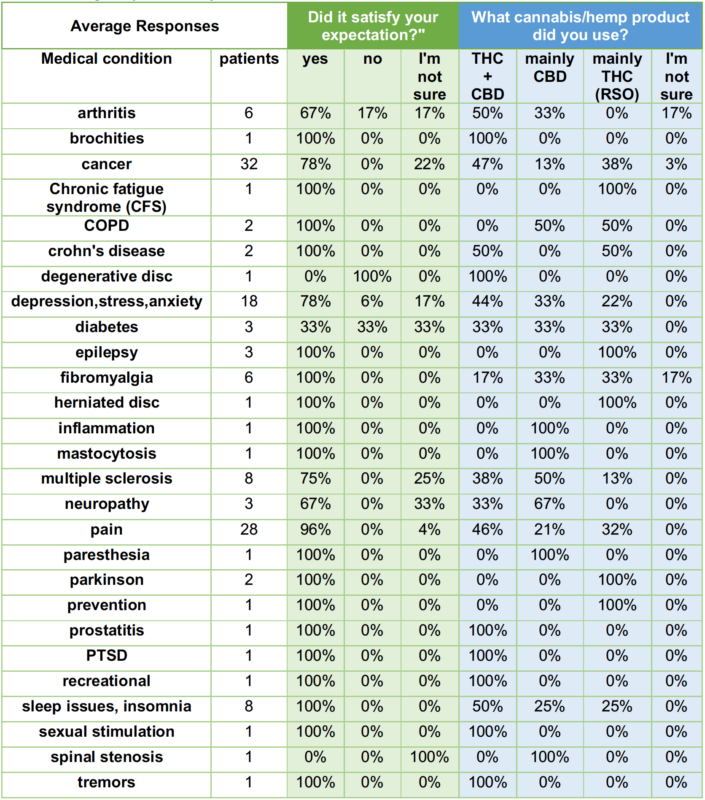Medical cannabis: Preliminary results of clinical study on the influence on various health conditions
Updated on: 05 July 2021
Optimizing therapeutic cannabis use can be a challenge – for doctors as well as patients. Most physicians never learned about cannabis in medical school and, according to a 2017 survey, few feel they are qualified to counsel patients about dosage, CBD:THC ratios, different modes of administration, and potential side effects.
This article will help you to decided which product will suit your needs. [Reading time ±10-30min]
We conducted our own clinical study to investigate the effects of cannabis products on various health condition. The main goal is that it could contribute to a better understanding of these effects and help to improve cannabinoid derived products.
The results were obtained from 135 patients from 8 different European countries that have filled an evaluation form about their use and experiences of cannabis derived products.
Health Conditions researched
Patients who involved in this research had a wide range of health conditions. Related health conditions were combined as one group to allow a better fitting result. As such, all cancer types were combined into one group, this applied also for patients that indicated to use cannabis to ease pain due to cancer. Other patients indicated to use cannabis for various types of pain relief or chronic pain, therefore, all causes of pain (with the exception of cancer) were combined into another group. Patients that indicated to have suffer from depression, stress and/or anxiety were also placed as one health condition group.
Cancer was found to be the present for the largest part of the patients (26,4% or 29 patients), followed by pain (16,4% or 21 patients) and depression, stress and/or anxiety (14,5% or 16 patients) as seen in Figure 1.
Furthermore, 7,3% of the patients used cannabis for multiple sclerosis, 6,4% used it for sleeping problems like insomnia, 5,5% used it for fibromyalgia. Other users indicated to have used cannabis products for arthritis, epilepsy, diabetes, neuropathy, spinal disorders, migraine, COPD, PTSD, Lyme, crohn’s disease, brochities, recreational use, sexual stimulation and more.
Figure 1. Use of cannabis products for health conditions or reasons
Effects of cannabis?
Patients were asked to indicate whether the cannabis products that they used for their health conditions did satisfy their expectation.
A staggering amount of 83,9% of the patients indicated that cannabis products indeed did satisfy their expectations to use it for their health condition. 12,9% was not sure and 3,2% indicated that it did not met their expectations (see figure 2).
Figure 2. Expectations of cannabis products from all patients.
78,6% of the 29 cancer patients that participated in this research indicated that the cannabis products satisfied their expectations, while 21,4% did not know if it has done anything (see figure 3).
Figure 3. Expectations of cannabis products from cancer patients.
95,7% of the 21 patients with pain, indicated that the cannabis products satisfied their expectations, while 4,3% did not know if it has done anything to them (see figure 4).
Figure 4. Expectations of cannabis products from patients with pain.
80,0% of the 16 patients, with depression, stress or anxiety, indicated that the cannabis products satisfied their expectations, while 13,3% did not know if it has done anything to them and 6,7% said it has not met their satisfaction (see figure 5).
Figure 5. Expectations of cannabis products from patients with depression, stress or anxiety.
Cannabinoids used
Cannabis comes from the cannabis plant and has active ingredients called cannabinoids that can help regulate a number of biological functions in many organisms. Delta-9-tetrahydrocannabinol (THC) is a cannabinoid that produces a “high” feeling that many users attribute to cannabis/marijuana, but it can also be beneficial for many side effects of cancer and its treatments. Cannabidiol (CBD) is another cannabinoid that has many potential applications in cancer and other serious medical conditions.
38,7% of the patients used a cannabis product that contained both THC and CBD, 32,3% of the patients used mainly products with THC and 26,6% used a product with mainly CBD. 2,4% was not sure what cannabis product they had used (see figure 6).
Figure 6. Cannabinoids used by all patients.
46,4% of the cancer patients used a cannabis product that contained both THC and CBD. 35,7% of these patients used mainly products with THC and 14,3% used a product with mainly CBD. 3,6% was not sure what cannabis product they had used (see figure 7).
Figure 7. Cannabinoids used by patients with cancer.
43,5% of the patients, that mentioned to use it for pain relief, used a cannabis product that contained both THC and CBD. 34,8% of these patients used mainly products with THC and 21,7% used a product with mainly CBD (see figure 8).
Figure 8. Cannabinoids used by patients with pain.
40,0% of the 16 patients, that mentioned to use it for either depression, stress relief or anxiety, used a cannabis product that contained both THC and CBD. 33,3% of these patients used mainly products with CBD and 26,7% used a product with mainly THC (see figure 9).
Figure 9. Cannabinoids used by patients with stress/depression/anxiety.
A recent 2020 study found that cannabidiol improves blood flow to parts of the brain associated with memory and decision-making. MRI scans showed CBD increased blood flow to the hippocampus, responsible for memories and the orbitofrontal cortex, responsible for decision-making. Researchers say the findings could be an important discovery for conditions which affect memory, such as Alzheimer’s disease and post-traumatic stress disorder (PTSD), and could help better target therapies.
Table 1 below shows the average responses of patients that used cannabis products for other health conditions.
Table 1. Average responses in % for various health conditions.
We will update these results frequently!
MICRODOSING FOR BEGINNERS
One of the common misconceptions about cannabis therapy is that you have to get high to attain symptom relief.
“Most people are surprised to learn that the therapeutic effects of cannabis can be achieved at dosages lower than those required to produce euphoria or impairment,” says Dr. Sulak, who asserts that “ultra-low doses can be extremely effective, sometimes even more so than the other [high-dose] extreme.”
Preclinical science lends credence to the notion that a small amount of THC can confer health benefits. Oral administration of a low dose of THC (1 mg/day) resulted in significant inhibition of disease progression” in an animal model of heart atherosclerosis (hardening of the arteries), according to a 2005 report in Nature, which noted: “This effective dose is lower than the dose usually associated with psychotropic effects of THC.”
Because of cannabis prohibition and consequent research restrictions, clinical data is lacking to determine if low dose THC therapy can protect against atherosclerosis in humans. But this much is certain: The practice of micro-dosing – which entails the consumption of a sub-psychoactive or slightly psychoactive dose of cannabis – is gaining popularity among those who want the medical benefits of cannabis without the buzz.
Although banned by law, cannabis medicine is currently accessible in the form of concentrated oil extracts, infused sublingual sprays, tinctures, edibles, gel caps, topical salves and other products, each with a different concentration.
MANAGING PSYCHOACTIVITY
The successful use of cannabis as a medicine largely depends on managing its intoxicating properties. Many people enjoy the cannabis high; for others it’s unpleasant. A person’s sensitivity to THC, the main intoxicating component of cannabis, is key to implementing an effective treatment regimen.
“The practice of micro-dosing – which entails the consumption of a sub-psychoactive or slightly psychoactive dose of cannabis – is gaining popularity among those who want the medical benefits of cannabis without the buzz.”
Cannabidiol (CBD) does not cause an intoxicating high like THC. CBD can actually lessen or neutralize the THC high, depending on how much of each compound is present in a particular product. A greater ratio of CBD-to-THC means less of high. Today cannabis patients have the option of healing without feeling high.
Determining how to use Cannabis products first starts with choosing your route of administration – in other words, choosing the best way to take Cannabis oil for your needs and lifestyle.
“Take one drop per day,” is one of the most common dosage recommendations we hear. While this can definitely be a dosage, there’s no way to tell if its the right dosage for the given individual as it doesn’t take into account important factors such as:
- The concentration of CBD
- The weight of the individual
- The individual’s body chemistry
- The severity of the condition being treated
With that being said, there isn’t a “one size fits all” dosage, and there will be some trial and error while gauging your proper dosage.
Start small and increase gradually. When in doubt, consult your physician or doctor, especially if you have an existing medical condition.
Broadly speaking, there are three types of resin-rich cannabis and cannabis products:
- Type 1 (THC-dominant) – High THC, low CBD (famously intoxicating cannabis varietals)
- Type 2 (THC & CBD) – Mixed THC and CBD cultivars (intoxicating, but not as edgy as THC-dominant varietals)
- Type 3 (CBD-dominant) – High CBD, low THC (non-euphoric marijuana or hemp)
“START LOW, GO SLOW”
The adage “Start small and increase gradually” is apropos for cannabis therapy, in general, and THC titration in particular, as discussed by Caroline MacCallum and Ethan Russo in a January 2018 article in the European Journal of Internal Medicine. The authors, who are both physicians, provide sensible guidelines for health professionals and patients regarding the judicious administration of (Type 1) THC-dominant medicinal preparations.
If a new patient is going to smoke or vape THC-rich cannabis, Russo and MacCallum suggest they start with a single inhalation and wait 15 minutes before inhaling again. The effects of inhaled cannabis usually can be felt within a few minutes, thereby providing quick relief of acute distress. If need be, one can inhale an additional puff every 15 to 30 minutes “until desired symptom control is achieved.”
As for oral administration, one should keep in mind that it can take 60 to 90 minutes before the effects of a single dose are felt.
MacCallum and Russo suggest a carefully titrated regimen for consumption of ingestible THC-rich cannabis products. They recommend that patients with little or no experience using cannabis should start by ingesting the equivalent of 1.25 to 2.5 mg of THC shortly before bedtime for two days. If there are no unwanted side effects, increase the bedtime dose of THC by another 1.25 to 2.5 mg for the next two days. Continue to increase the dose of THC by an additional 1.25 to 2.5 mg every other day until the desired effects are achieved.
If there are adverse side effects, reduce the dose of THC to the prior amount that was well tolerated.
https://www.youtube.com/watch?v=v1SmzbMhj5o
DIFFERENT TYPES, DIFFERENT DOSAGE
TYPE 1 – TITRATING THC
For adequate symptom relief, some patients may need to ingest a cannabis preparation two or three times during daylight hours in addition to their night-time regimen. Cautious titration is urged: On days 1 and 2, start with one dose of the equivalent of 2.5 mg THC; on days 3 and 4, increase to 2.5 mg THC twice a day; and, if well tolerated, up the dose incrementally to a total of 15 mg THC (divided equally throughout the day).
“Doses exceeding 20-30 mg/day [of THC] may increase adverse events or induce tolerance without improving efficacy,” MacCallum and Russo warn.
Adverse events mainly pertain to THC and are dose-dependent. Very high doses are more likely to cause unwanted side effects.
In practical terms, this means that starting low and gradually upping the dose of cannabis will produce stronger effects at first. But, after a certain point, “dosage increases can result in weaker therapeutic effects,” according to Dr. Sulak, “and an increase in side effects.” It is important to note that every body responds to THC differently, and builds tolerance at different rates. Check in with yourself often while consuming cannabis to gauge the effects and side effects.
There are some negative side effects that can result from over-consumption. Sulak observes that “symptoms of cannabis overdose closely mirror the symptoms one would expect cannabis to relieve at appropriate doses: nausea, vomiting, diarrhea, sweating, spasms, tremors, anxiety, panic attacks, paranoia, dis-coordination, and disturbed sleep. Extreme overdoses can lead to hallucinations and even acute psychosis.”
By introducing small amounts of THC into your system, and increasing the dosage slowly, you minimize the risk of negative side effects. The goal is to take a large enough dose of THC to achieve therapeutic effects and a small enough dose to minimize negative side effects.
TYPE 2 – THC AND CBD: THE POWER COUPLE

CBD and THC are the power couple of cannabis therapeutics. Both compounds have remarkable medicinal attributes, and they work better in combination than as isolates. CBD can synergistically enhance THC’s anti-inflammatory and pain killing properties, while reducing unwanted side effects.
A 2010 report in the British Journal of Pharmacology analyzed the effects of THC and CBD alone and in combination in an animal model of colitis. This preclinical study concluded that “CBD increased some effects of an ineffective THC dose to the level of an effective one.”
This is one of the many gifts of CBD: It can magnify the medicinal impact of a small amount of THC so that one need not consume an intoxicating dose to experience THC’s therapeutic benefits.
A clinical study published in the Journal of Pain examined the efficacy of different dosage levels of Sativex, a cannabis-derived sublingual spray with 1:1 CBD:THC ratio, which is an approved medication in two dozen countries (but not in the United States). Of 263 cancer patients who were not finding pain relief with opiates, the group that received 21 mg of Sativex each day experienced significant improvements in pain levels, more so than the group that received 52 mg Sativex daily. And those given even higher doses (83 mg daily) reduced their pain no better than a placebo, but they experienced more adverse effects.
Although many patients do well at the lowest effective dose, some benefit from a high dose cannabis oil regimen. Often these patients engage in a regimen that includes a substantial amount of CBD as well as THC. By reducing THC’s intoxicating effects, CBD makes high potency cannabis oil treatment easier to manage. If high doses are necessary, steady titration over several weeks will help build tolerance to THC’s tricky intoxicating effects.
Cannabis therapeutics is personalized medicine. There is no single CBD:THC ratio or dosage that’s optimal for everyone. As little as 2.5 mg of CBD combined with a small amount of THC can have a therapeutic effect. If necessary, much higher doses of good quality CBD-rich formulations are safe and well tolerated.
For patients new to cannabis, it may be best to start with low doses of a CBD-rich remedy (with little THC) and increase the dosage (and, if necessary, the amount of THC) step-by-step. Take a few small doses over the course of the day, rather than one big dose.
But a low-THC product is not always the best treatment option. A more balanced combination of CBD and THC could have a greater impact than CBD or THC alone.
In essence, the goal is to administer consistent, measurable doses of a CBD-rich remedy with as much THC as a person is comfortable with. Experiment, observe the effects, and adjust the amount of CBD and THC until one finds the sweet spot with the right combination of both compounds.
TYPE 3 – FULL-SPECTRUM CBD-RICH EXTRACTS
Microdosing cannabis is a feasible option for those who prefer not to leap over the intoxicating threshold. High dose CBD therapy is another way of healing without the high.
As a general rule, Type 3 CBD-dominant cannabis (with little THC) won’t make a person feel stoned. Nor will a pure CBD isolate (with no THC). But CBD isolates lack critical aromatic terpenes and other cannabinoids, which interact synergistically to enhance CBD’s therapeutic benefits. Single molecule cannabinoids are simply not as versatile or as efficacious as whole plant formulations.
Preclinical research indicates that full spectrum CBD-rich cannabis oil is effective at much lower doses and has a wider therapeutic window than a CBD isolate. “The therapeutic synergy observed with plant extracts results in the requirement for a lower amount of active components, with consequent reduced adverse side effects,” a 2015 Israeli study concluded. In animal studies, CBD isolates require very high – and precise – doses to be effective. Problematic drug interactions are also more likely with a high-dose CBD isolate than with whole plant cannabis.
In a 2012 clinical trial involving 39 schizophrenics at a German hospital, 800 mg of pure pharmaceutical-grade CBD proved to be as effective as standard pharmaceutical treatments without causing the harsh side effects typically associated with antipsychotic drugs. But a follow-up study at Yale University found little cognitive improvement in schizophrenics who were given a CBD isolate.
PHARMACEUTICAL CBD
Bereft of the THC stigma (and its therapeutic moxy), single-molecule CBD recently became a FDA-approved pharmaceutical for pediatric seizure disorders. This is good news for families with epileptic children that have health insurance. Anyone without health insurance won’t be able to afford Epidiolex, a nearly pure CBD remedy developed by GW Pharmaceuticals as an anti-seizure medication.
Consider the dosage range utilized in clinical trials of epidiolex. Children with catastrophic seizure disorders were given up to 20 mg of epidiolex per kg of body weight. Such high doses caused interactions with other anticonvulsant medications, requiring adjustments of the latter to avoid a toxic overdose.
By comparison, Dr. Bonni Goldstein, author of Cannabis Revealed, typically starts with a much lower dose of full spectrum CBD-rich oil (1 mg CBD/kg of body weight) for epileptic children – with the understanding that the dose may have to be lowered or raised depending on the initial response. If necessary, Goldstein will increase the dose of CBD by increments of 0.5 mg/kg until a threshold of 5 mg/kg of body weight is reached. And that amount also may need to be adjusted.
Kids and adults metabolize drugs differently. It may seem counterintuitive, but young children can tolerate high doses of cannabis oil concentrates, including THC-rich formulations, which might be daunting for an adult. Thus, it’s not a good idea to calculate dosage for an adult based on what works for a child.
If 1 mg/kg of CBD is an appropriate starting dose for a child, and an adult weighs 15 times more than the child, one should not assume that the correct CBD starting dose for the grown-up is 15mg/kg of body weight. That could be way too high a dose. While CBD has no known adverse effects at any dose, an excessive amount of CBD may be less effective therapeutically than a moderate dose. Similarly, it’s not a good idea to devise a dosage regimen based on data from preclinical animal studies, which usually involve high doses of single-molecule cannabinoids. Human metabolism differs from mice and rats, and data from animal models doesn’t always translate to human experience.
PERSONALIZED MEDICINE
For people as well as pets, cannabis dosage must be individually determined. Several factors come into play, including one’s overall health and endocannabinoid tone, which are influenced by diet, exercise, sleep patterns, day-to-day stress, and genetics. Cannabis is best used as part of a healthy lifestyle.
Here are some dosage variables to consider:
- Cannabis experience. Has the patient used cannabis before? Or are they a stoner who already uses cannabis every day but isn’t getting the best results? A veteran user may need a higher dose than a new user. Or a chronic user might need a break from getting high to reboot his or her sensitivity to cannabis.
- Time of day. Optimizing one’s therapeutic use of cannabis may entail using products with different CBD:THC ratios at different times of the day – more CBD for daylight hours, more THC at night.
- Preventive dosing. Prolonged low dose therapy may be advantageous for managing chronic symptoms or to prevent disease recurrence. Preclinical studies indicate that cannabinoids have neuroprotective and cardioprotective properties that could limit the damage of a traumatic brain injury or a heart attack.
Cannabis is a safe and forgiving medicine. Figuring out how to make the most of its health-enhancing properties may involve some trial and error. No worries! At least cannabis isn’t harmful like so many FDA-approved pharmaceuticals.
So if you’re new to cannabis medicine or if you’re seeking to improve your therapeutic routine, remember this advice from Dr. Sulak: “Start low, go slow, and don’t be afraid to go all the way!”
Once you have decided which cannabinoid will best suit your needs, we can find the best fitting product(s) and you can then try to find your optimal dosage with a dosage program.
 Based on +200
reviews
Based on +200
reviews

